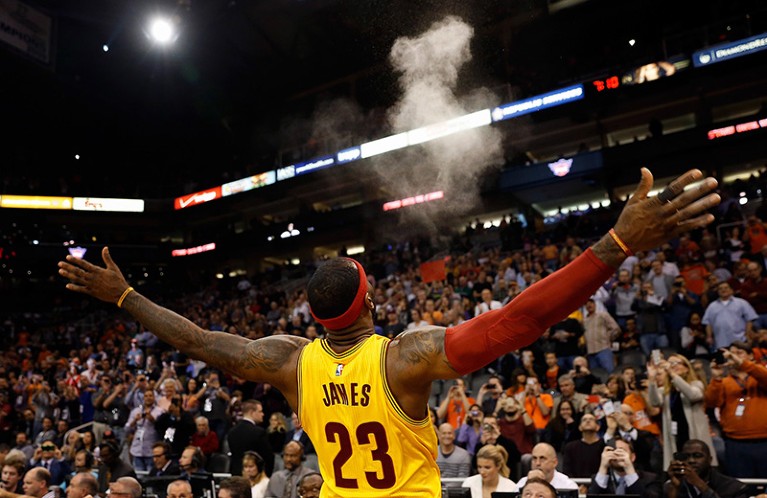
From sports to science, success seems to come in hot streaks.Credit: Christian Petersen/Getty
“There are no second acts in American lives,” wrote F. Scott Fitzgerald, and he should know. He never quite equalled the form he found with his novel The Great Gatsby in 1925 — although some might say neither has anyone else.
The phenomenon of form — and how it can cluster into claimed hot streaks — is much discussed by movie buffs. Does anyone doubt that the Oscars for Martin Scorsese’s 2006 film The Departed were belated recognition for the director’s peerless streak between 1973 (Mean Streets) and 1980 (Raging Bull)? For that matter, has Robert de Niro ever topped his performances in the latter film and in Scorsese’s Taxi Driver (1976)? It’s the same story in music: the stars of Madonna, Björk and Beyoncé have all shone their brightest at particular times.
Read the paper: Hot streaks in artistic, cultural, and scientific careers
Such examples could suggest that if you haven’t produced any big hits by the middle of your career, you’ve missed your chance. But a study published this week in Nature offers hope for those still waiting (L. Liu et al. Nature https://doi.org/10.1038/s41586-018-0315-8; 2018). It examines the occurrence of hot streaks — runs of high-impact works — in the oeuvres of tens of thousands of film-makers, artists and scientists. It finds that most careers contain at least one relatively hot streak, and that this occurs at an apparently random stage in an individual’s sequence of works.
From ‘hot hands’ in basketball to ‘momentum’ in football, folk wisdom tends to dominate discussions of form, just as it does beliefs about gamblers’ winning streaks. Some will claim that ‘everyone knows’ artists and scientists produce their best work when they are young: Mary Shelley wrote Frankenstein at 19, and Jocelyn Bell Burnell was in her 20s when she discovered the first pulsar. But then, how to explain the late second blooming of novelist Philip Roth? Others place the peak of performance at mid-career, when the benefits of experience aren’t yet counteracted by declining faculties — look, for example, at the musicians Ella Fitzgerald and Nina Simone.
The new analysis, which looks at crowdsourced film ratings and art auction prices, says that there is no typical career point for a hot streak. The authors argue that creative impact shows the features of ‘bursty dynamics’ — just like other human traits, including movement and e-mail and telephone communications (K.-I. Goh & A.-L. Barabási EPL 81, 48002; 2008). This is not quite the same as saying that large or significant events happen at random; rather, their occurrence is correlated, such that the average time between successive events is smaller than random. If one occurs, another is likely to follow soon — but that sequence can’t last long. That’s precisely what a hot streak is.
For the 20,000 scientists included in the study, the proxy for impact was the citations of an individual’s papers over the ten-year period following each paper’s publication. One could quibble that some scientific papers draw most attention only decades after publication — but that’s rather rare. Hot streaks here correspond to a run of papers cited significantly more than an individual’s average.
The good news is that around 90% of artists and scientists have at least one such hot streak in their career. The bad news is that it’s typically not repeated: 64% of artists and 68% of scientists have only one, and more than two is very rare. F. Scott Fitzgerald was mostly right, then. And there might be little one can do to influence the matter: hot streaks do not, for example, correlate with productivity. The authors of the study make no claim that ‘impact,’ as they measure it, is a good proxy for creativity. After all, there’s still no consensus about how creativity should be defined and measured, let alone whether or how it can be cultivated and nurtured. And scientific impact goes beyond citations.
Indeed, it would be a sad day when the intrinsic value of a work was judged by how much it can be sold for. But the disconnect between popularity and worth perhaps goes to the heart of what to make of these findings. To use economics terminology, are the dynamics of success endogenous — driven by the fluctuating inspiration of the creator, say — or exogenous, produced by the vicissitudes of the marketplace? It’s tempting to imagine a bit of both: that the creator suddenly finds he or she has tapped into the zeitgeist — only to discover, a little further down the line, that the world has moved on.
Maybe the most appealing message, however, is that the dynamics of science are no different from those of the arts: success in both depends on a resonance between the individual’s imagination and the shifting moods and desires of the audience.

 Read the paper: Hot streaks in artistic, cultural, and scientific careers
Read the paper: Hot streaks in artistic, cultural, and scientific careers
 Citation is not the only impact
Citation is not the only impact
 The science that’s never been cited
The science that’s never been cited



